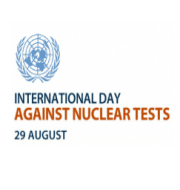29 August: International Day Against Nuclear Tests
The International Day Against Nuclear Tests is observed on 29 August across the world to raise awareness about the effects of nuclear weapon test explosions or any other nuclear explosions.
Observance of the day calls for the urgent need to prevent nuclear catastrophes to avert devastating effects on humankind, the environment and the planet. It also highlights urgent need for cessation of nuclear weapons as one of the means of achieving the goal of a nuclear-weapon-free world.
On this day various events are organised across the world such as symposia, conferences, exhibits, competitions, publications, instruction in academic institutions, media broadcasts etc.
Background
- The International Day against Nuclear Tests was instituted by the United Nations General Assembly (UNGA) by unanimously adopting resolution 64/35 on 2 December 2009.
- The resolution was initiated by the Kazakhstan with support of large number of sponsors and cosponsors with a view to commemorate the closure of the Semipalatinsk Nuclear Test site on 29 August 1991.
- The Day was first celebrated in 2010 and since then observed annually to galvanize the necessity of banning nuclear weapon tests.
About Semipalatinsk Nuclear Test site
- The Semipalatinsk Test Site (also known as The Polygon) was the primary testing venue for the Soviet Union’s nuclear weapons.
- It is located on the steppe in northeast Kazakhstan (then the Kazakh SSR part of USSR), south of the valley of the Irtysh River.
- The Soviet Union had conducted 456 nuclear tests on this site from 1949 until 1989 with little regard for their effect on the local people or environment.
Month: Current Affairs - August, 2016


